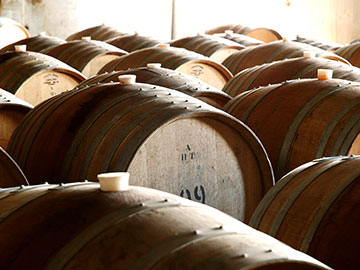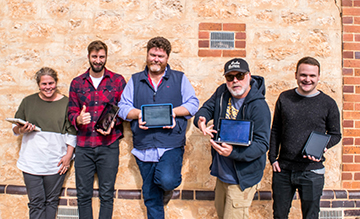Cool vintage means higher malic acid levels
Using magnetic nanoparticles for protein stabilisation
Unlocking wine flavour during tasting
Past and future of grape crushing
ShowRunner – all-in-one wine show management software
Call for submissions on wine processing aids
Order the latest AWRI staff publications online
Cool vintage means higher malic acid levels |
|
 |
Many winemakers have been calling the helpdesk concerned about higher titratable acidity (TA) levels in their wines due to the cooler year and associated higher levels of malic acid in fruit. Reports of 4 g/L malic are typical in regions that normally might only have half this amount. Lallemand has reported similar feedback from industry. If wines go through malolactic fermentation (MLF), the malic will be converted to lactic acid and winemakers have asked how this will affect the pH and TA.
The pH increase post-MLF will be higher than usual due to the higher starting levels of malic acid. Theoretically, each gram per litre (g/L) of malic acid contributes 1.12 g/L to the TA expressed in terms of tartaric acid. If all of the malic acid is converted to lactic acid, the TA (expressed as tartaric acid) will drop by 0.56 g/L for each g/L of malic acid that was originally present in the wine. For example, if a wine starts with 4 g/L of malic acid, the TA would be expected to drop by 2.24 g/L and the pH could increase approximately 0.2 after MLF. |
Using magnetic nanoparticles for protein stabilisationBentonite fining to remove haze-forming proteins is a key step in the production of white and rosé wines, but has some drawbacks including wine losses and waste disposal issues. A new separation technology is showing potential as a bentonite alternative. The technique uses magnetic nanoparticles – nanometre-scale particles that can be moved around using magnetic fields. Different coatings can be placed on these particles that allow them to bind to different compounds. In a recently published AWRI study, a coating designed to specifically bind haze-forming wine proteins was used. The coated particles were placed in heat-unstable wine, where the proteins bound to the nanoparticles’ surfaces. The particles were then able to be removed from the wine using a magnet. Testing of the wine following the treatment found that the haze-forming proteins were removed, even from wines with very high protein content. Other components, such as wine phenolics, were unaffected. This technique therefore has potential to be used in the wine industry as an alternative to bentonite fining or could find applications in other areas such as water treatment or biotechnology. The full paper detailing these results is accessible via the AWRI library: Mierczynska-Vasilev, A., Boyer, P., Vasilev, K., Smith, P.A. A novel technology for the rapid, selective, magnetic removal of pathogenesis-related proteins from wines. Food Chem. 232: 508-514.; 2017. |
|
Upcoming events |
|
 |
With vintage finishing up in most regions, the events team has been busy planning the 2017 calendar, and is scheduling a wide range of events for grape and wine producers. From June the new roadshow workshop ‘Addressing regional challenges’ will be rolled out to the Barossa Valley, Mornington Peninsula, Gippsland, Yarra Valley, Mount Barker, Pemberton, Margaret River and Swan Valley regions.
In late May/early June there will be two Advanced Wine Assessment Courses and a wine show judging course to develop tasters’ wine judging skills. Both AWACs are full; however, there are still spaces left for the Wine show judging – an insider’s view of panel tastings course to be held on Friday, 9 June. This is a unique opportunity for participants to hone their wine judging skills under Australian wine show conditions, with guidance from some of Australia’s top wine show chairs. On Thursday, 29 June Olaf Schelezki from the University of Adelaide will present a webinar entitled ‘Pre-fermentative addition of water or low alcohol wine into juice to manage alcohol levels of red wine’. Register here to attend. The online AWRI events calendar and the Grape and wine events calendar are being continually updated – so please check back regularly to keep in touch with events in your region or contact the events team on events@awri.com.au or 08 8313 6600 if you have any queries. |
Unlocking wine flavour during tastingA long persistent palate is a hallmark of high quality wine and recent research may have identified the wine compounds responsible for this characteristic. The work showed that glycosides present in wine can break down in the mouth when a wine is tasted, contributing to lingering fruity or floral flavour. A glycoside consists of a flavour molecule bound to a sugar molecule that renders it flavourless. Previously, glycosides had been thought not to contribute to wine flavour, as it was believed they needed the action of fermentation enzymes or slow chemical reactions during ageing to break them apart and release the flavour molecule. Sensory panellists tasted samples of glycosides from white wines and analysis showed that bacterial enzymes in saliva could unlock the bound flavour compounds in the glycosides, releasing a wave of flavour that continued after the wine was swallowed. The amount of these glycosides in a wine could perhaps be used by winemakers as a quality marker, indicating the potential for a wine to have a long palate. The full paper detailing these results is accessible via the AWRI library: Parker, M., Black, C.A., Barker, A., Pearson, W., Hayasaka, Y., and Francis, I.L. 2017. The contribution of wine-derived monoterpene glycosides to retronasal odour during tasting. Food Chem. 232, 413-424. |
|
ShowRunner – all-in-one wine show management software |
|
 |
The AWRI has developed a new software system to manage all aspects of running a wine show. Incorporating online entries, electronic scoring and instant results, ShowRunner brings all administration and manual functions together to make running a wine show simple and seamless.Used by the Langhorne Creek Wine Show this month and other wine shows last year, the software has already been adopted by a number of Australian wine shows for 2017, with interest also coming from overseas.
The online entry module allows exhibitors to enter details of their wines once and then enter across multiple shows. Entry fees can also be paid online. Show organisers can monitor entries in preparation for judging and judges use iPads to enter their scores and comments. The results are generated instantly. To find out more about ShowRunner or to organise a demonstration, contact Francesca Blefari or Con Simos on events@awri.com.auor phone 08 8313 6600. |
Past and future of grape crushingCrushing is in important step in the production of most red wines. Classically, this process was performed by foot treading but the process started to be mechanised in the early 19th century. Since then, a range of crushing equipment has been used, with relatively gentle overlapping lobe roller crushers the most common today. Lately there has been some renewed interest in different and more intense crushing equipment because of the potential for enhanced colour extraction or reduced skin contact time. A recently published article on the evolution and future directions for crushing equipment is now available from the AWRI website. |
|
Call for submissions on wine processing aidsFood Standards Australia New Zealand (FSANZ) recently called for submissions on an application to permit the use of four new processing aids in wine. The processing aids—chitin-glucan, PVI/PVP co-polymers, ammonium hydrogen sulfite and silver chloride—are already permitted for use in the European Union. More information about the application can be found on the FSANZ website. The closing date for submissions is 6pm (Canberra time) 7 June 2017. |
|
Order the latest AWRI staff publications onlineAccessing the latest AWRI publications is easy. Visit the AWRI Publications web page to:
A full list of AWRI publications published since the last eNews is included below: 1901 Hayasaka, Y., Black, C.A., Hack, J., Smith, P. Structural characterization of reaction products of caftaric acid and bisulfite present in a commercial wine using high resolution mass spectrometric and nuclear magnetic resonance techniques. Food Chem. 230: 99-107; 2017. 1902 Corsi, A.M., Cohen, J., Lockshin, L., Williamson, P. Testing lexical equivalences for wine flavours in emerging markets: do hawthorns taste like blackberries? Food Qual. Pref. doi: 10.1016/j.foodqual.2017.03.011: 28 p.; 2017. 1903 Holdstock, M. Ask the AWRI: Taints in wine. Aust. N.Z. Grapegrower Winemaker (638): p. 64; 2017. 1904 Mierczynska-Vasilev, A., Boyer, P., Vasilev, K., Smith, P.A. A novel technology for the rapid, selective, magnetic removal of pathogenesis-related proteins from wines. Food Chem. 232: 508-514.; 2017. 1905 Parker, M., Black, C.A., Barker, A., Pearson, W., Hayasaka, Y., Francis, I.L. The contribution of wine-derived monoterpene glycosides to retronasal odour during tasting. Food Chem. 232: 413-424; 2017. 1906 Nguyen, T.T., Barber, A.R., Smith, P., Luo, X., Zhang, W. Application and optimization of the highly efficient and environmentally-friendly microwave-intensified lactic acid demineralization of deproteinized Rock lobster shells (Jasus edwardsii) for chitin production. Food Bioprod. Process. 102: 367-374; 2017. 1907 Capello, M.S., Zapparoli, G., Logrieco, A., Bartowski, E.J. Linking wine lactic acid bacterial diversity with wine aroma and flavour. Int. J. Food Microbiol. 243: 16-27; 2017. 1908 Varela, C., Barker, A., Tran, T., Borneman, A., Curtin, C. Sensory profile and volatile aroma composition of reduced alcohol Merlot wines fermented with Metschnikowia pulcherrima and Saccharomyces uvarum. Int. J. Food Microbiol. 252: 1-9; 2017. 1909 Ristic, R., van der Hulst, L., Capone, D.L., Wilkinson, K.L. Impact of bottle aging on smoke tainted wines from different grape cultivars. J. Agric. Food Chem. doi: 10.1021/acs.jafc.7b01233: 27 p.; 2017. 1910 Nordestgaard, S. Gentle or intense grape crushing? Aust. N.Z. Grapegrower Winemaker (639): 77-82; 2017. 1911 Cowey, G. Ask the AWRI: Adding water to high sugar must. Aust. N.Z. Grapegrower Winemaker (639): 88-89; 2017. 1912 Longbottom, M. Fellows of the ASVO. Wine Vitic. J. 32(2): p. 10; 2017. 1913 Bindon, K., Smith, P., Schulkin, A., Dambergs, B., Kassara, S., Barter, S., Solomon, M., Cynkar, W., Capone, D., McRae, J., Francis, L., Robinson, E., Johnson, D. Exploring the potential for grape objective measures to predict wine grade and style. Wine Vitic. J. 32(2): 46-47; 2017. 1914 Dry, P. Durif. Wine Vitic. J. 32(2): p. 55; 2017. |
|
AcknowledgementThe AWRI acknowledges support from Australia’s grapegrowers and winemakers through their investment body, Wine Australia, with matching funds from the Australian Government. The AWRI is a member of the Wine Innovation Cluster in Adelaide, South Australia. |
|

